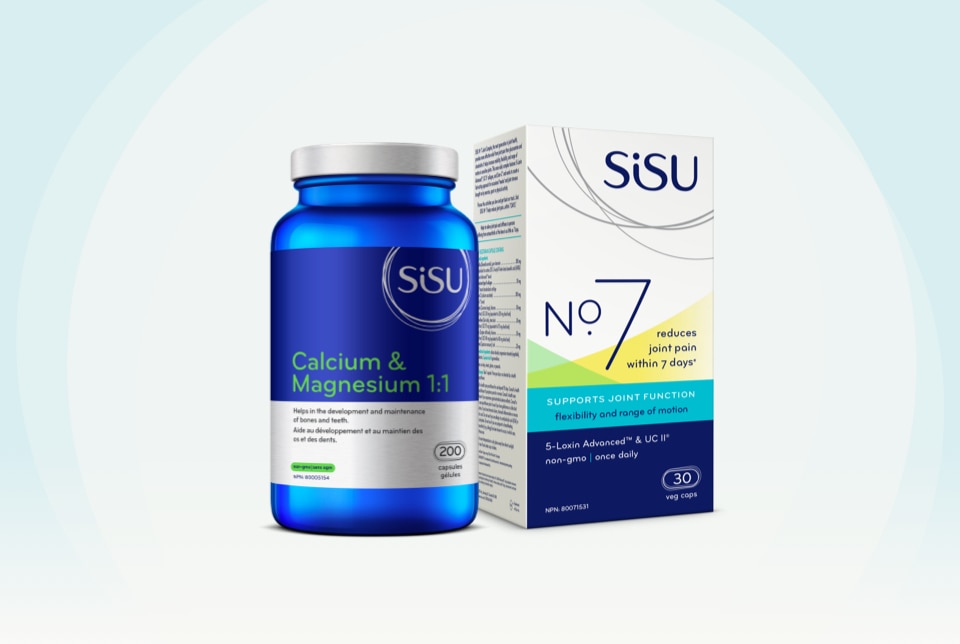
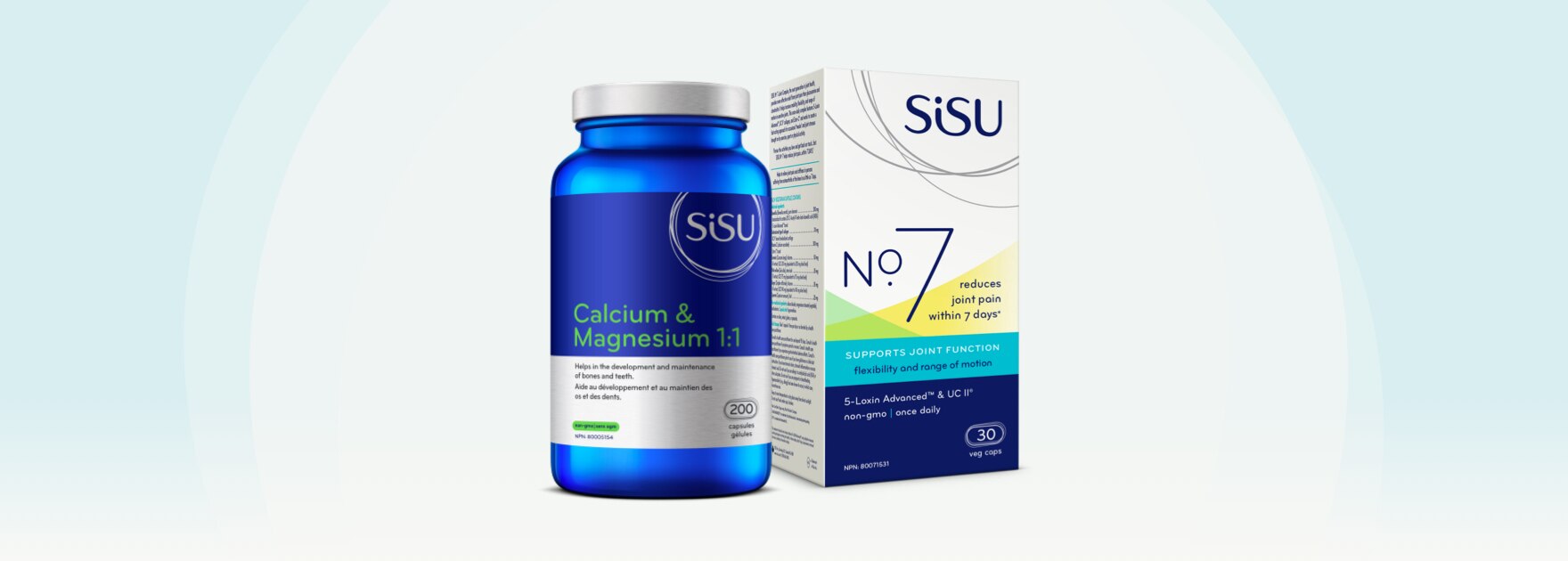
Have you ever thought about how much your bones change over time? Bone is a living tissue that constantly replaces old bone cells with new ones. However, this process slows down with age, especially for people over 50. As a result, you gradually start to lose bone mass and are more prone to developing osteoporosis.1
Thankfully, it’s possible to delay and even prevent this bone loss at any age. Let’s look at the steps you can take to support bone density and reduce your risk of osteoporosis.
What is bone density?
Bone density refers to the amount of bone mineral content in bone tissue. When your bone mineral content is higher, your bones are more dense, strong, and less likely to fracture. You’re also less likely to be affected by osteoporosis.2
What is osteoporosis?
Osteoporosis is characterized by low bone mass and gradual bone mineral loss over time, which weakens the bone and risks a fracture. The most common fractures occur in the hip, spine, wrist, and shoulder. Osteoporosis is known as the “silent thief” because it often takes years to develop without any symptoms.3
How to check if you have low bone density
Many people who develop osteoporosis don’t know they have it until they get a fracture. These fractures typically occur spontaneously from a simple activity (ie. bending) or minor injury (ie. falling from standing height). Luckily, there are a couple of ways to know your risk to help better protect your bone health and slow bone mineral loss.
Know your risk
There are a number of factors that could put you at greater risk for breaking a bone or developing osteoporosis. Let’s unpack some of them:
Age: While osteoporosis can affect people at almost any age, it is most common among Canadians 50 years of age or older.4
Sex: While both men and women are affected by bone loss, lower estrogen levels can increase the risk of women developing osteoporosis during menopause. Estrogen is a hormone that helps make new bone cells.5
Family History: If you have a family member that has been diagnosed with osteoporosis or a parent who had a hip fracture, you may be at increased risk for bone loss.6
Medications: Some medications may increase bone loss and risk of a fracture when used over a long period of time. These medications include:7
- Breast Cancer drugs
- Prostate Cancer drugs
- Heartburn drugs
- Blood pressure medication
Always check with your healthcare practitioner to learn more about how your medications could be affecting your bones.
Medical Conditions: Certain medical conditions may also cause bone loss or increase the chances of a fracture, such as:8
- Rheumatoid arthritis
- Chronic kidney disease
- Diabetes
- Neurological disorders (cerebral palsy, multiple sclerosis, etc.)
Always check with your healthcare practitioner to learn more about how your medical conditions could be affecting your bones.
Diet: A diet low in calcium and high in caffeine contributes to a faster decline of bone loss or early bone loss.9
Lack of physical activity: Like our muscles, bones become stronger with exercise. Without regular exercise, your risk for weakened bone density increases.10
Take a bone mineral density test
A Bone Mineral Density (BMD) Test is a safe and painless X-ray test used to measure the density of your bones and determine your likelihood of osteoporosis in the future. If you want to better determine your risk with a BMD, we recommend consulting with your healthcare provider for next steps.
Now, let’s dive into the steps you can take to improve your bone density.
5 ways to support bone density
1. Do weight-bearing exercises
Go put some weight on those bones—literally! Research has shown that doing weight bearing exercises, which places increased stress on your bones, helps to stimulate new bone growth, increases your bone density, and helps to prevent osteoporosis.11
Weight-Bearing Exercises for Strong Bones12 |
||
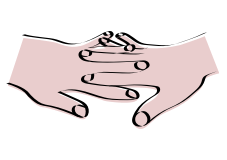 |
Stretching and balancing exercises | |
| How often | Every day | |
| Examples | Tai Chi and yoga help to improve balance and strength. | |
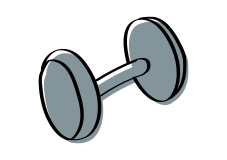 |
Strength Training | |
| How often | At least 2 days/week | |
| Examples | Using free weights, resistance bands or lifting your own body weight to work all major muscle groups. | |
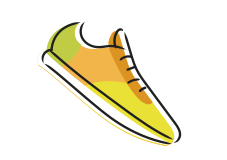 |
Aerobic exercises | |
| How often | At least 150 minutes/week | |
| Examples | Brisk walking, running, dancing, etc. | |
Always consult with your healthcare provider before beginning any exercise program.
Get support from a joint health supplement
If you struggle with occasional joint pain, don’t let it hinder your activities. Sisu No. 7 combines 7 active ingredients, including clinically-studied 5-Loxin Advanced™ and UC II® Collagen to help support joint function.
2. Eat calcium-rich foods
Your bones need calcium to grow just as much as we need oxygen to breathe. Calcium is an important nutrient that bones need to support their development through everyday wear. Canada’s Food Guide recommends 3 servings per day of milk and alternatives for those over 50, and 2 servings per day for adults under 50.13
Examples of calcium rich-foods for bones14
| Dairy | Non-Dairy |
| Yogurt – plain, fruit-flavoured | Fortified beverages – orange juice, soy, almond and rice milk |
| Milk – whole, 2%, 1%, skim, chocolate | Soybeans, white beans |
| Cheese – Blue, Brick, Cheddar, Edam, Gouda, Gruyere, Swiss, Mozzarella | Canned salmon or sardines |
| Leafy green vegetables – spinach and collards |
Get support from a bone health supplement
If you’re unable to get enough calcium from your diet, a supplement like Sisu Calcium Magnesium 1:1 can help in the development and maintenance of healthy bones.
3. Eat sufficient protein
Along with calcium, diets that include recommended amounts of protein are associated with greater bone mass and a lower risk for bone loss and osteoporosis.15 In general, adults (19 years and over) need 0.8 grams of protein per day for every kilogram of body weight.16
Examples of protein-rich foods for bones17
- Eggs
- Fish and shellfish: salmon, shrimp, trout, scallops, mackerel
- Lean meats and poultry: beef, pork, chicken, turkey
- Nuts and seeds: peanuts, almonds, cashews, nut butters
- Beans, peas and lentils: chickpeas, black beans, kidney beans
4. Get plenty of vitamin D
Calcium and vitamin D are equal players when it comes to bone health. Calcium helps to build new bone cells while vitamin D helps your body better absorb calcium. One of the best ways to get vitamin D is through the sun, but our skin’s ability to make vitamin D decreases as we age.
Most Canadians also don’t get enough direct sun exposure during the long winter months when the days are shorter, and we’re inside a lot more. If you’re struggling to get vitamin D through the sun, supplementation is a great way to ensure you’re getting enough.
Reduce your risk of osteoporosis with a supplement
Osteoporosis Canada recommends vitamin D supplementation for Canadian adults year-round.12 Our new Vitamin D softgels and tablets offer 2,500 IU of vitamin D3, the maximum dosage permitted in a Canadian natural health product. D3 is also the most popular form of Vitamin D. When combined with sufficient calcium, a healthy diet and regular exercise, both products may reduce the risk of developing osteoporosis. Plus, they’re easy-to-swallow, non-GMO, and gluten-free.
5. Limit caffeine and alcohol
There’s nothing wrong with a steaming cup of joe in the morning, but if you’re a caffeine fiend you might want to think twice. High-caffeine intake decreases the amount of calcium the body can absorb, especially if your calcium consumption is already low.19 For optimal bone health, The Dieticians of Canada recommend no more than 400 mg of caffeine per day, which equals around three cups of coffee.20
Likewise, limiting alcohol consumption is another important proactive measure to prevent the risk of breaking your bones through a trip or fall. If you drink, follow Canada’s Low Risk Drinking Guidelines.
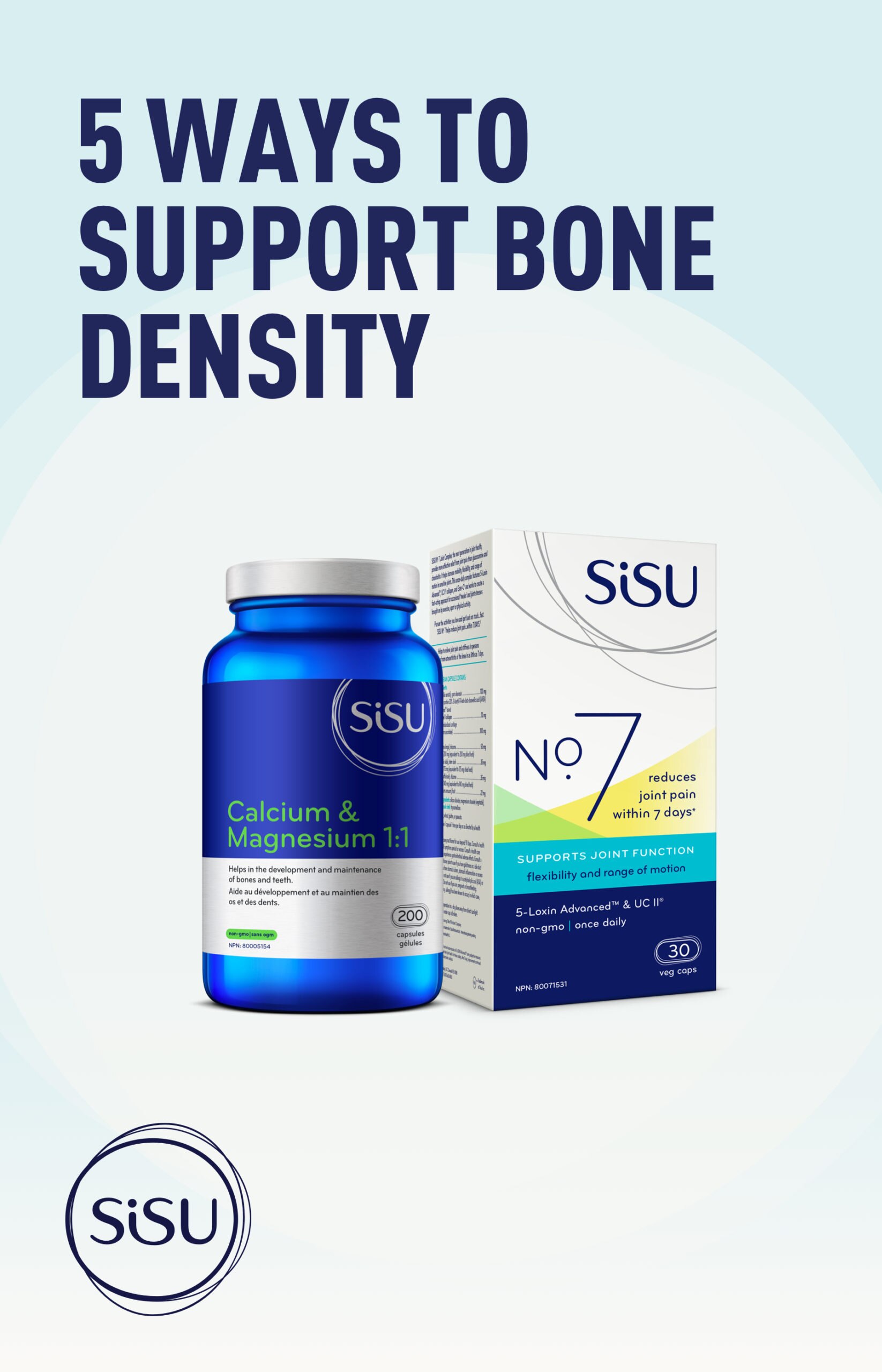
Tune up your bone health
Your bones need plenty of care and attention to be their healthiest and strongest. By following these steps, you’re helping to slow bone loss and reducing your risk of osteoporosis.
To add more quick health and wellness tips to your feed, follow us on Instagram! (@sisuvitamins)
Always read and follow the product label. Products may not be suitable for everyone.
1 https://www.hopkinsmedicine.org/health/conditions-and-diseases/osteoporosis/osteoporosis-what-you-need-to-know-as-you-age
2 https://www.hopkinsmedicine.org/health/conditions-and-diseases/osteoporosis/osteoporosis-what-you-need-to-know-as-you-age
3 https://osteoporosis.ca/signs-and-symptoms/
4 https://osteoporosis.ca/risk-factors/
5 https://osteoporosis.ca/risk-factors/
6 https://osteoporosis.ca/risk-factors/
7 https://osteoporosis.ca/medications-that-can-cause-bone-loss-falls-and-or-fractures/
8 https://osteoporosis.ca/medical-conditions-that-can-cause-bone-loss-falls-and-or-fractures/
9 https://osteoporosis.ca/nutrition/
10 https://osteoporosis.ca/exercise/
11 https://www.ncbi.nlm.nih.gov/pmc/articles/PMC6323511/
12 https://osteoporosis.ca/exercise/
13 https://osteoporosis.ca/calcium/
14 https://osteoporosis.ca/calcium-rich-foods/
15 https://osteoporosis.ca/protein/
16 https://www.unlockfood.ca/en/Articles/Protein/Introduction-To-Protein-And-High-Protein-Foods.aspx
17 https://food-guide.canada.ca/en/healthy-eating-recommendations/make-it-a-habit-to-eat-vegetables-fruit-whole-grains-and-protein-foods/eat-protein-foods/
18 https://osteoporosis.ca/vitamin-d/
19 https://pubmed.ncbi.nlm.nih.gov/12204390/
20 https://www.unlockfood.ca/en/Articles/Bone-Health/7-Tips-to-Help-Keep-Your-Bones-Strong.aspx#.VpQg6MArKuU

